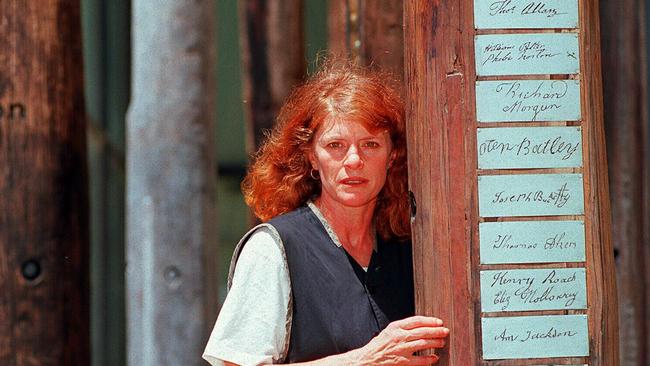Communing with nature: The botanical art of Janet Laurence
I discovered Australian artist Janet Laurence 15 years ago when I was starting to write about trees.

I discovered Australian artist Janet Laurence 15 years ago when I was starting to write about trees. Stomping around the edge of Sydney Harbour, I happened on two of her collaborative installations.
The first was Edge of the Trees, made with Fiona Foley for the Museum of Sydney. It raised a forest of 29 various pillars, including recycled ironbark and tallow wood, above the site of the colonial settlement’s first government house. Some were inscribed with the indigenous and Latin names of species that had been abundant nearby, and the whole was encased with a gentle murmur of sound, recovering the sense of the place before the First Fleet moved in.
The second was Veil of Trees, a collaboration with Jisuk Han that interspersed 101 river red gum seedlings, glass panels inscribed with poetry and other artefacts along the ridge that borders Sydney’s Royal Botanic Gardens and runs down to Mrs Macquarie’s Chair.
Each tree was grown from the seeds of forest red gums — Eucalyptus tereticornis — that predated the fleet’s 1788 arrival, and I loved the sense of restitution, of botanical time travel, inherent in the act of replanting them more than 200 years later.
Laurence navigates an interface between the arts and sciences, ecologies and aesthetics, extinctions and celebrations. She is keenly interested in the intersections between humans and their environments; in the frailties and pressure points at both ends of that equation; and in the possibilities of succour as well.
Her signature pieces transport slices of wilderness, nature — the whole botanical-floral-biotic world liberated from the shorthand of “landscape” or “backdrop” — into gallery settings, or relocate versions or modifications of that “wild” stuff back into delineated natural settings, like the grove of trees growing above Mrs Macquarie’s Chair.
Standing there, I felt as if some of the ideas I’d wanted to wrestle into sentences had been realised in front of me, in three dimensions and with beautiful simplicity. In a way, Laurence’s works provided the sculptural equivalent of that perfect reading moment Australian novelist Tegan Bennett has described as “the sense that one was just about to think what is on the page; the sense that that thought was only waiting for the writer to express it for us”.
I think Prudence Gibson would understand this reaction. In Janet Laurence: A Pharmacy of Plants, she identifies Laurence as “an established and highly respected international artist”, “a curious and adventurous soul”, someone whose work has “affected our national creative imagination”. Her book focuses on Laurence’s bio-art: her assemblages and installations of seeds, plants, crystals, mirrors, images, pigments and all manner of “vegetal matter” in works that may resemble labs, potting sheds, even emergency rooms for vast trees wired up to suggest medications, resuscitations.
She emphasises Laurence’s emphasis that “nature exists with or without humankind and that we will always fail to completely understand what nature is”. She returns to this point — “the finite ability of humans to comprehend the world” if we will insist on placing ourselves at its centre — in several chapters.
Gibson responds to Laurence’s art through the prism of “an aesthetic of enhancement” as much as the idea of duty of care. Against the necessary weight of ideas of damage and disappearance, Laurence’s installations can act like “a cool hand … on the back of a feverish neck”. And the lyricism of many of her descriptions and meditations matches the delicacy of Laurence’s works, captured here on 32 glossy pages.
This book exists at a kind of heightened pitch. It’s a scholarly enterprise — “an academic and theoretical discussion”, as Gibson concludes — and its impressive raft of theories and terminologies may wrongfoot some readers.
Laurence is discussed in the context of Paul Virilio’s “picnolepsy”, or “moments of panicked lapses into consciousness”, itself a perfect prism through which to consider many of our intersections with the rest of the planet’s organisms. We are invited to see her work as framed by Alistair Crowley and alchemy. And I was grateful to be reading this book hot on the heels of MR O’Connor’s Resurrection Science, which also took to the field of “object-oriented ontology”, a fascinating philosophical study of existence that affords nothing a particularly special status, be it human or otherwise. There are other delightful resonances between O’Connor’s book and this one, particularly in Gibson’s discussion of Laurence evoking, re-creating and, yes, resurrecting nature in the environments she crafts for her shows.
Gibson catches the thinking that informs and is informed by Laurence’s creativity and pins it like delicate specimens across these pages. If she credits artists with often being “the best people to lead us towards change”, she credits Laurence’s particular pieces with a critical kind of beauty. Laurence describes her own art as trying to “still time, to achieve a kind of perfection”, and through the cumulative and repurposed nature of her focus, she achieves that in spades.
Ultimately, the book left me where a monograph should, wanting to get into Laurence’s world, wanting to stand among her work again and feel its layers of thought and care. However you travel through this text, that is its primary purpose: to champion and cherish this extraordinary Australian artist and to bring her to the forefront of our imaginations.
Ashley Hay is a novelist and critic.
Janet Laurence: The Pharmacy of Plants
By Prudence Gibson
NewSouth, 192pp, $49.99



To join the conversation, please log in. Don't have an account? Register
Join the conversation, you are commenting as Logout